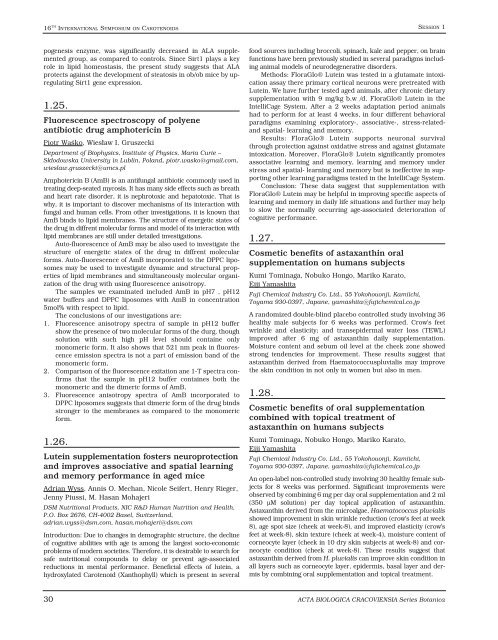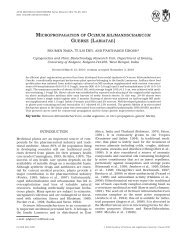ACTA BIOLOGICA CRACOVIENSIA
ACTA BIOLOGICA CRACOVIENSIA
ACTA BIOLOGICA CRACOVIENSIA
Create successful ePaper yourself
Turn your PDF publications into a flip-book with our unique Google optimized e-Paper software.
16 TH INTERNATIONAL SYMPOSIUM ON CAROTENOIDS<br />
pogenesis enzyme, was significantly decreased in ALA supplemented<br />
group, as compared to controls. Since Sirt1 plays a key<br />
role in lipid homeostasis, the present study suggests that ALA<br />
protects against the development of steatosis in ob/ob mice by upregulating<br />
Sirt1 gene expression.<br />
1.25.<br />
Fluorescence spectroscopy of polyene<br />
antibiotic drug amphotericin B<br />
Piotr Waśko, Wiesław I. Gruszecki<br />
Department of Biophysics, Institute of Physics, Maria Curie –<br />
Skłodowska University in Lublin, Poland, piotr.wasko@gmail.com,<br />
wieslaw.gruszecki@umcs.pl<br />
Amphotericin B (AmB) is an antifungal antibiotic commonly used in<br />
treating deep-seated mycosis. It has many side effects such as breath<br />
and heart rate disorder, it is nephrotoxic and hepatotoxic. That is<br />
why, it is important to discover mechanisms of its interaction with<br />
fungal and human cells. From other investigations, it is known that<br />
AmB binds to lipid membranes. The structure of energetic states of<br />
the drug in diffrent molecular forms and model of its interaction with<br />
lipid membranes are still under detailed investigations.<br />
Auto-fluorescence of AmB may be also used to investigate the<br />
structure of energetic states of the drug in diffrent molecular<br />
forms. Auto-fluorescence of AmB incorporated to the DPPC liposomes<br />
may be used to investigate dynamic and structural properties<br />
of lipid membranes and simultaneously molecular organization<br />
of the drug with using fluorescence anisotropy.<br />
The samples we examinated included AmB in pH7 , pH12<br />
water buffers and DPPC liposomes with AmB in concentration<br />
5mol% with respect to lipid.<br />
The conclusions of our investigations are:<br />
1. Fluorescence anisotropy spectra of sample in pH12 buffer<br />
show the presence of two molecular forms of the durg, though<br />
solution with such high pH level should containe only<br />
monomeric form. It also shows that 521 nm peak in fluorescence<br />
emission spectra is not a part of emission band of the<br />
monomeric form,<br />
2. Comparison of the fluorescence exitation ane 1-T spectra confirms<br />
that the sample in pH12 buffer containes both the<br />
monomeric and the dimeric forms of AmB,<br />
3. Fluorescence anisotropy spectra of AmB incorporated to<br />
DPPC liposomes suggests that dimeric form of the drug binds<br />
stronger to the membranes as compared to the monomeric<br />
form.<br />
1.26.<br />
Lutein supplementation fosters neuroprotection<br />
and improves associative and spatial learning<br />
and memory performance in aged mice<br />
Adrian Wyss, Annis O. Mechan, Nicole Seifert, Henry Rieger,<br />
Jenny Piussi, M. Hasan Mohajeri<br />
DSM Nutritional Products, NIC R&D Human Nutrition and Health,<br />
P.O. Box 2676, CH-4002 Basel, Switzerland,<br />
adrian.wyss@dsm.com, hasan.mohajeri@dsm.com<br />
Introduction: Due to changes in demographic structure, the decline<br />
of cognitive abilities with age is among the largest socio-economic<br />
problems of modern societies. Therefore, it is desirable to search for<br />
safe nutritional compounds to delay or prevent age-associated<br />
reductions in mental performance. Beneficial effects of lutein, a<br />
hydroxylated Carotenoid (Xanthophyll) which is present in several<br />
food sources including broccoli, spinach, kale and pepper, on brain<br />
functions have been previously studied in several paradigms including<br />
animal models of neurodegenerative disorders.<br />
Methods: FloraGlo® Lutein was tested in a glutamate intoxication<br />
assay there primary cortical neurons were pretreated with<br />
Lutein. We have further tested aged animals, after chronic dietary<br />
supplementation with 9 mg/kg b.w /d. FloraGlo® Lutein in the<br />
IntelliCage System. After a 2 weeks adaptation period animals<br />
had to perform for at least 4 weeks, in four different behavioral<br />
paradigms examining exploratory-, associative-, stress-relatedand<br />
spatial- learning and memory.<br />
Results: FloraGlo® Lutein supports neuronal survival<br />
through protection against oxidative stress and against glutamate<br />
intoxication. Moreover, FloraGlo® Lutein significantly promotes<br />
associative learning and memory, learning and memory under<br />
stress and spatial- learning and memory but is ineffective in supporting<br />
other learning paradigms tested in the IntelliCage System.<br />
Conclusion: These data suggest that supplementation with<br />
FloraGlo® Lutein may be helpful in improving specific aspects of<br />
learning and memory in daily life situations and further may help<br />
to slow the normally occurring age-associated deterioration of<br />
cognitive performance.<br />
1.27.<br />
Cosmetic benefits of astaxanthin oral<br />
supplementation on humans subjects<br />
Kumi Tominaga, Nobuko Hongo, Mariko Karato,<br />
Eiji Yamashita<br />
Fuji Chemical Industry Co. Ltd., 55 Yokohouonji, Kamiichi,<br />
Toyama 930-0397, Japane, yamashita@fujichemical.co.jp<br />
A randomized double-blind placebo controlled study involving 36<br />
healthy male subjects for 6 weeks was performed. Crow's feet<br />
wrinkle and elasticity; and transepidermal water loss (TEWL)<br />
improved after 6 mg of astaxanthin daily supplementation.<br />
Moisture content and sebum oil level at the cheek zone showed<br />
strong tendencies for improvement. These results suggest that<br />
astaxanthin derived from Haematococcuspluvialis may improve<br />
the skin condition in not only in women but also in men.<br />
1.28.<br />
Cosmetic benefits of oral supplementation<br />
combined with topical treatment of<br />
astaxanthin on humans subjects<br />
Kumi Tominaga, Nobuko Hongo, Mariko Karato,<br />
Eiji Yamashita<br />
Fuji Chemical Industry Co. Ltd., 55 Yokohouonji, Kamiichi,<br />
Toyama 930-0397, Japane, yamashita@fujichemical.co.jp<br />
SESSION 1<br />
An open-label non-controlled study involving 30 healthy female subjects<br />
for 8 weeks was performed. Significant improvements were<br />
observed by combining 6 mg per day oral supplementation and 2 ml<br />
(350 μM solution) per day topical application of astaxanthin.<br />
Astaxanthin derived from the microalgae, Haematococcus pluvialis<br />
showed improvement in skin wrinkle reduction (crow's feet at week<br />
8), age spot size (cheek at week-8), and improved elasticity (crow's<br />
feet at week-8), skin texture (cheek at week-4), moisture content of<br />
corneocyte layer (cheek in 10 dry skin subjects at week-8) and corneocyte<br />
condition (cheek at week-8). These results suggest that<br />
astaxanthin derived from H. pluvialis can improve skin condition in<br />
all layers such as corneocyte layer, epidermis, basal layer and dermis<br />
by combining oral supplementation and topical treatment.<br />
30 <strong>ACTA</strong> <strong>BIOLOGICA</strong> <strong>CRACOVIENSIA</strong> Series Botanica












